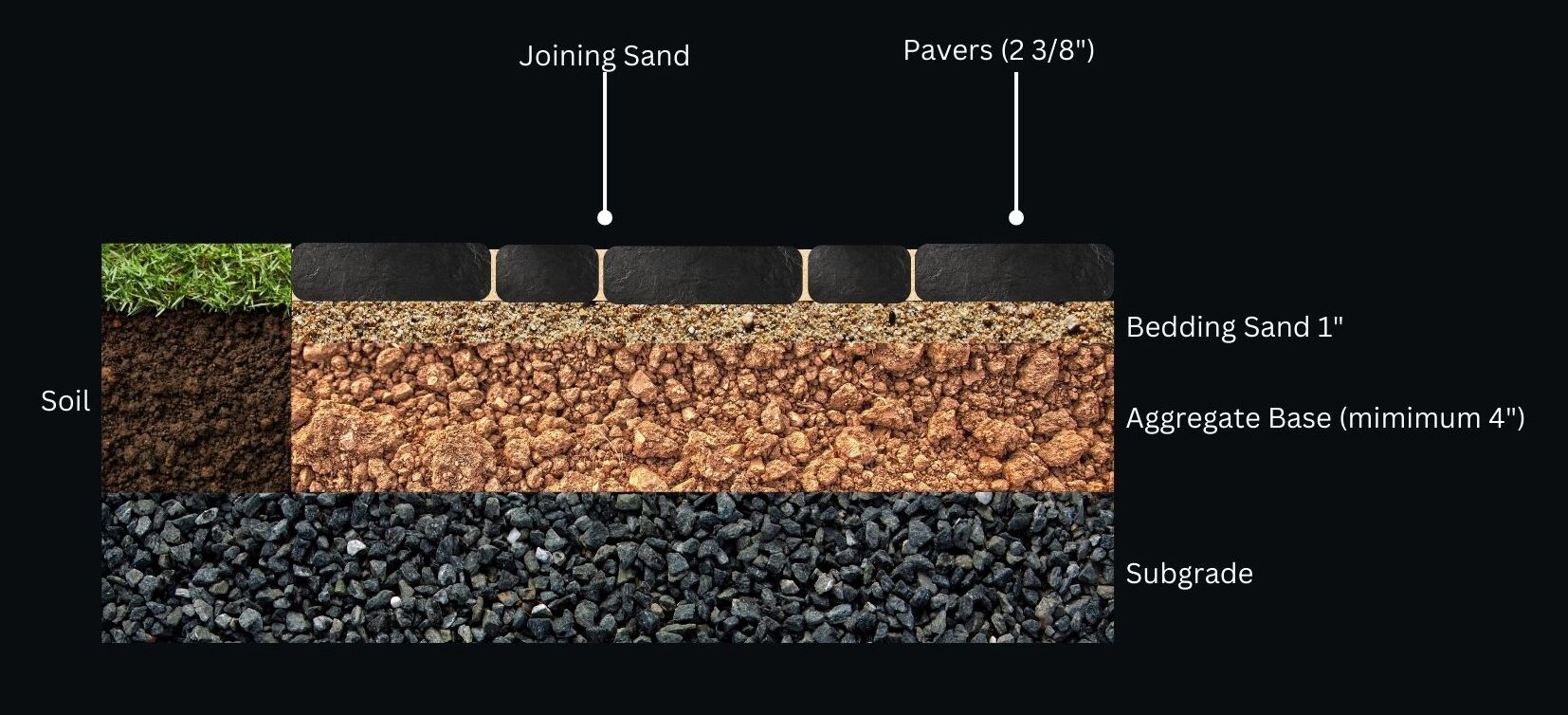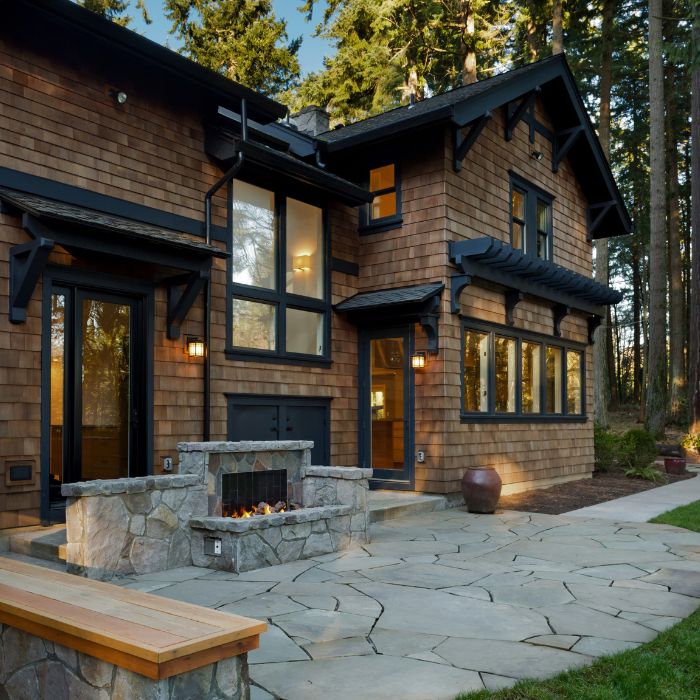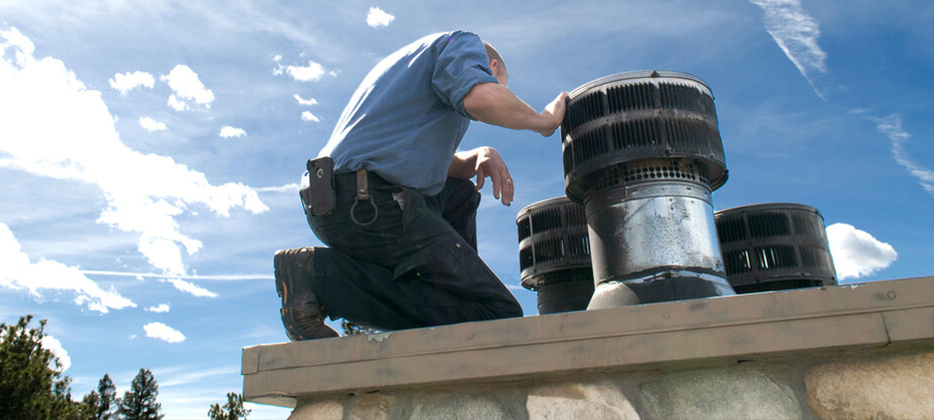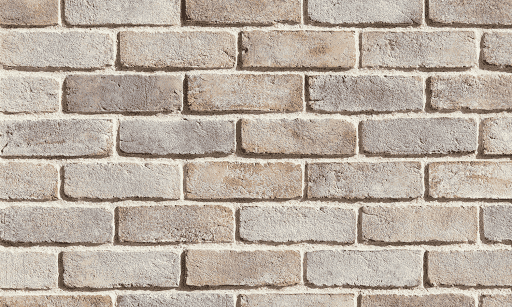Patios
Build | Repair
Patio Brick Designs

Traditional Brick
- Traditional brick patios use standard rectangular or square bricks. They offer a classic and timeless appearance, with various colors to choose from.

Herringbone
- Herringbone patterns involve arranging bricks at a 45-degree angle, creating a V-shaped design. This pattern adds visual interest and a touch of elegance to the patio.

Basketweave
- Basketweave patterns use pairs of bricks laid horizontally and vertically to create a woven look. It offers a unique and intricate design.

Circular
- Circular brick patios are designed with a circular or curved layout, creating a focal point in the outdoor space. They are visually appealing and can accommodate seating or a fire pit at the center.

Tumbled Brick
- Tumbled bricks have worn and weathered edges, providing a rustic and aged appearance. They add character and charm to the patio.

Permeable Brick
- Permeable brick patios are eco-friendly as they allow water to drain through the gaps between the bricks. They help reduce runoff and promote groundwater recharge.
Stone Patio Materials
Patio Construction

Planning and Design
Purpose
Determine the purpose of your patio (e.g., dining area, entertainment space, relaxation area).
Location
Choose the location, size, and shape of the patio.
Factors to Consider
Consider factors like sun exposure, privacy, and accessibility.
Create Design
Create a rough sketch or use design software to visualize your patio layout.
Budget
Set a budget for the project, including materials, labor, and any additional features.
Obtain Permits
Check with your local authorities to determine if you need permits or approvals for your patio construction. Regulations vary by location.
Gather Materials and Tools
Materials
Depending on your design, gather the necessary materials, including pavers, bricks, stones, sand, gravel, and landscaping fabric.
Tools
Acquire the tools needed for the project, such as a shovel, wheelbarrow, level, measuring tape, mallet, and a compactor.
Factors to Consider
Consider factors like sun exposure, privacy, and accessibility.
Site Preparation
Cleanup
Clear the area of any debris, grass, or vegetation.
Excavation
Excavate the site to the desired depth, typically around 6-8 inches for a stable base.
Drainage
Ensure proper slope for drainage away from your home or other structures.
Base Preparation
Landscape Fabric
Spread a layer of landscape fabric over the excavated area to prevent weeds from growing.
Gravel
Add a layer of gravel or crushed stone, and use a compactor to create a firm and level base.
Edging Installation
Install edging materials, such as plastic, metal, or stone, to define the patio’s borders and hold the pavers or bricks in place.
Setting the Patio Material
Laying Brick/Stone
Begin laying your chosen patio material (pavers, bricks, stones) in your desired pattern or design, starting from one corner or edge.
Level
Use a level to ensure each piece is even and properly aligned.
Spacing
Leave small gaps between the stones or pavers for drainage and expansion.
Cutting and Trimming
As needed, cut stones or pavers to fit the edges or corners using a saw or chisel..
Sand or Grout
Gravel
Spread a layer of sand or fine gravel over the patio surface.
Fill Gaps
Use a broom to sweep the sand into the gaps between the patio materials.
Mortar
For brick patios, you can also use mortar or grout to secure the bricks in place.
Compact and Level
Use a compactor to settle the patio materials and ensure a stable, even surface.
Popular Patio Shapes

Curved Patios
Curved patios soften the angular lines of a landscape and create a sense of flow and movement. They are particularly well-suited for winding pathways, naturalistic gardens, and irregularly shaped outdoor spaces.
Rectangular Patios
A classic and versatile option, rectangular patios are well-suited for both small and large outdoor spaces. They provide ample room for furniture arrangements and can easily complement various architectural styles.
L-Shaped Patios
L-shaped patios wrap around corners or structures, maximizing available space and providing multiple seating areas. They are versatile and can be adapted to fit various backyard configurations, including corner lots or irregularly shaped yards.
Circular Patios
Circular patios add visual interest and create a focal point in the outdoor area. They are ideal for creating intimate seating areas or accommodating round dining tables. Circular patios can be standalone or integrated into larger patio designs.
Multi-Level Patios
Multi-level patios feature distinct tiers or platforms at different elevations, creating visual interest and defining separate zones for dining, lounging, or entertaining. They are ideal for sloped or uneven terrain and can enhance the overall landscape design.
Patio Repair

Cracked or Loose Stones/Bricks:
Over time, stones or bricks in your patio may become cracked or loosened due to various factors such as settling of the ground, freeze-thaw cycles, or heavy traffic. These issues not only compromise the aesthetic appeal of your patio but also pose a safety hazard.

Replacing Cracked or Loose Stones/Bricks:
Remove damaged stones or bricks and replace them with new ones of similar size and style. Ensure proper compaction of the base material and use a quality adhesive or mortar to secure the replacements in place.

Uneven Surface:
Uneven surfaces can develop due to shifting ground, improper installation, or settling over time. This can lead to tripping hazards and discomfort when walking or sitting on the patio.

Leveling and Resurfacing:
Address uneven surfaces by leveling the ground or resetting the stones/bricks to create a smooth and uniform surface. Consider adding a layer of sand or gravel to improve drainage and stability.

Weed Growth:
Gaps between stones or bricks can become breeding grounds for weeds and other vegetation. Not only does this detract from the appearance of your patio, but it can also cause structural damage over time as plant roots grow and expand.

Weed Control:
Remove weeds and vegetation from between stones/bricks manually or with the help of herbicides. Consider installing landscape fabric or polymeric sand between joints to inhibit weed growth while allowing for drainage.
Concrete
Affordability: Concrete is often the most budget-friendly option for patios, making it a popular choice for homeowners on a tight budget.
Versatility: Concrete can be poured and stamped into various patterns and textures, allowing for customization to match your aesthetic preferences.
Durability: Concrete is durable and long-lasting, able to withstand heavy foot traffic, weather exposure, and fluctuations in temperature.
Brick
Classic Appearance: Brick offers a timeless and elegant look, adding charm and character to outdoor spaces.
Low Maintenance: Brick requires minimal maintenance, with occasional sweeping and rinsing to keep it clean. It is resistant to staining and fading.
Permeability: Porous brick allows water to drain through, reducing the risk of puddling and providing a cooler surface in hot weather.
Stone
Beauty and Elegance: Natural stone, such as flagstone or slate, offers unmatched beauty and visual appeal, with unique colors, textures, and patterns.
Longevity: Natural stone is incredibly durable and can last a lifetime with proper maintenance. It can withstand harsh weather conditions and heavy use.
Variety: There is a wide range of natural stone options available, allowing for customization to suit your style preferences and complement your landscape design.
Pavers
Ease of Installation: Pavers are precast concrete or stone units that are easy to install and can be arranged in various patterns and designs.
Flexibility: Pavers come in a variety of shapes, sizes, colors, and textures, providing endless design possibilities to create a unique patio.
Repairability: Individual pavers can be easily replaced if damaged, without the need to replace the entire patio surface.
What Factors Determine the Cost of a New Patio?

Patio Size
The size of the patio is one of the most significant factors affecting the cost. Larger patios require more materials, labor, and time to install, resulting in higher overall costs.
Patio Material
The choice of material for the patio greatly influences the cost. Concrete is typically the most affordable option, while natural stone, pavers, and brick tend to be more expensive due to their higher material costs.
Patio Design and Complexity
Intricate designs, patterns, and shapes can increase the cost of the patio due to the additional labor and expertise required for installation. Complex designs may also require more materials and result in higher waste disposal costs.
Site Preparation
The condition of the site and the amount of preparation required can impact the cost of the patio. Clearing vegetation, leveling the ground, removing existing structures, and addressing drainage issues may incur additional expenses.
Accessibility
Accessibility to the patio site can affect the cost of materials delivery and equipment transport. Difficult-to-access locations may require special equipment or additional labor, resulting in higher installation costs.
Labor Costs
Labor costs vary depending on factors such as local labor rates, the complexity of the project, and the skill level of the contractors. More experienced and reputable contractors may charge higher rates for their services.
Additional Features
Additional features such as built-in seating, fire pits, outdoor kitchens, lighting, and landscaping can significantly increase the cost of the patio. These features require extra materials, labor, and specialized expertise to install.
Permits and Regulations
Depending on local regulations and building codes, permits may be required for patio construction. Permit fees and inspection costs can add to the overall project expenses.
Seasonality
The time of year when the patio is constructed can impact costs. Contractors may offer lower prices during the off-peak season when demand is lower, while prices may be higher during peak season due to increased demand.
Contractor Selection
The choice of contractor can also influence the cost of the patio. More experienced and reputable contractors may charge higher prices for their services, but they may also deliver higher quality workmanship and customer service.
Why Choose the Washington State Masonry Company?
With years of experience in the industry, they offer innovative design solutions tailored to your unique vision. Their skilled masons use high-quality materials to ensure durability and aesthetic appeal.
The company prides itself on attention to detail and timely project completion, making the construction process seamless and stress-free. Additionally, their competitive pricing and excellent customer service make them a top choice for creating beautiful, long-lasting outdoor spaces.
Trust Washington State Masonry Company to transform your patio dreams into reality.
Call for an Estimate
206-437-6582
FAQs
Can I customize the design of my patio?
Absolutely! Our masonry experts can work with you to design a patio that suits your preferences and complements your outdoor space. We offer various patterns, colors, and materials to choose from.
Is it possible to incorporate features like fire pits or kitchens into my patio design?
Yes, we can integrate features like fire pits, outdoor kitchens, seating walls, and more into your masonry patio design to create a functional and inviting outdoor living space.
Can you work with my budget?
Absolutely, we understand that budget constraints vary. Our team can work with you to find a solution that fits your budget while still achieving your desired patio design.
How often do I need to clean my patio?
It’s recommended to clean your patio at least once a year to remove dirt, debris, and stains. However, if your patio is exposed to heavy foot traffic or environmental factors such as tree sap or bird droppings, more frequent cleaning may be necessary.
Shop Masonry Services
Fireplaces
Materials
Chimneys

Walls
Cleaning
Latest Articles

How Often Does a Gas Fireplace Chimney Need to Be Cleaned?
A gas fireplace chimney needs to be cleaned at least once a year. Annual cleaning prevents carbon monoxide leaks, ensures proper ventilation, improves efficiency, and identifies potential issues like blockages or corrosion,...

How Much Does It Cost to Finish a Basement Project?
Finishing a basement project typically costs between $7,000 and $23,000, depending on size, materials, and labor. High-end projects can exceed $35,000. How Much Does It Cost to Finish a Basement? The cost of finishing a basement...

Which Brick is Right for Your Project?
Bricks are one of the oldest and most versatile building materials, used in construction for centuries. They come in various types, each with its unique properties and uses. Whether you're building a new home, renovating, or working on a landscape project, choosing...

The Washington State
Masonry Company
License No. BRICKBD809Q4
Same day or same week estimates and completions
5 year warranty on all workmanship
Based out of Federal Way, WA
Call Us At: 206-437-6582



